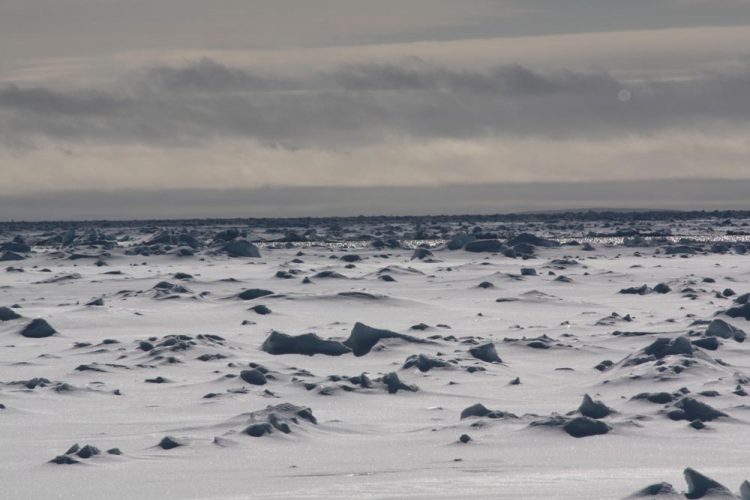Sea-ice zone has a major influence on the ecosystem

Impressionen vom Eis der Antarktis
In the last 30,000 years there was, at times, more mixing in the Southern Ocean than previously thought. This meant that vast quantities of nutrients were available to phytoalgae, which in turn contributed to storing the greenhouse gas CO2 during the last glacial period.
Researchers from the Alfred Wegener Institute, Helmholtz Centre for Polar and Marine Research (AWI) present these new findings in a study published in the journal Nature Communications.
“We can demonstrate that during the last glacial period, the water column in the area of the seasonal sea-ice zone was more mixed in autumn and winter than previously thought,“ says Dr Andrea Abelmann, from the Alfred Wegener Institute.
The marine geologist and first author of the study explains, “Only in the short southern spring and summer, for just a few months in the year, was there a marked stratification at the ocean’s surface. Up until now, researchers assumed that during the last glacial period there was a layer of freshwater – created by melting icebergs – that sat on the ocean like a lid all year round.
Such a lid would have greatly reduced the supply of nutrients from the ocean’s depths to the surface leading to low biological production. However, the new findings show that in the last glacial period in the seasonal sea-ice zone, which was twice as large as it is today, the water was well mixed to a depth of a few hundred metres. This allowed nutrients to reach the surface from deeper levels.
In addition, melting ice in spring released the trace element iron, which had been transported with dust from South America. This created ideal conditions for microscopic, exoskeleton algae (diatoms): they were able to effectively utilise the nutrients to bind carbon during photosynthesis and so store CO2. When they died, these phytoplankton sank to the ocean floor thousands of metres below.
In this process, also known as the biological pump, atmospheric CO2 is stored in sedimentary deposits over geological time periods. During the ice ages, storage of the greenhouse gas CO2 in the Southern Ocean contributed significantly to global cooling.
For their study, the researchers used newly developed methods to reconstruct sedimentary deposits from the Atlantic section of the Southern Ocean. They compared isotope measurements on the silica skeletons of diatoms, which store environmental signals from the ocean’s surface, with isotope signals from radiolarians, which live in deeper water layers.
They then compared the findings from different ocean depths with results from climate models simulations to identify seasonal changes. This enabled the research team to reconstruct, for the first time, a detailed picture of the environmental conditions at the ocean’s surface, as well as in deeper water layers, over the last 30,000 years.
“Our findings show that changes in the ecosystem in the area of the seasonal sea-ice zone in the Southern Ocean contributed to CO2 storage,” says Abelman, summing up the geologists’ and modellers’ findings. The study demonstrates that a combination of modern reconstruction techniques and models can provide new insights into seasonal processes. “In order to make future predictions, we have to look more closely at past processes and current changes together,” says the AWI researcher.
Original article:
Andrea Abelmann, Rainer Gersonde, Gregor Knorr, Xu Zhang, Bernhard Chapligin, Edith Maier, Oliver Esper, Hans Friedrichsen, Gerrit Lohmann, Hanno Meyer und Ralf Tiedemann: The seasonal sea-ice zone in the glacial Southern Ocean as a carbon sink. Nature Communications 6:8136. doi: 10.1038/ncomms9136 (2015).
Notes for Editors:
Please observe the embargo: 18 September 2015 10:00 a.m. London time (BST), 11:00 MEST; 05:00 US Eastern Daylight Time
You can find printable images in our media library: http://multimedia.awi.de/medien/pincollection.jspx?collectionName=%7B5242c01e-49…
Your scientific contact is Dr Gregor Knorr: phone: +49 471 4831-1769; e-mail: Gregor.Knorr(at)awi.de and in the Communications Dept. of the Alfred Wegener Institute Dr Folke Mehrtens: phone: +49 471 4831-2007; e-mail: Folke.Mehrtens(at)awi.de
The Alfred Wegener Institute, Helmholtz Centre for Polar and Marine Research (AWI) conducts research in the Arctic, Antarctic and oceans of the high and mid-latitudes. It coordinates polar research in Germany and provides major infrastructure to the international scientific community, such as the research icebreaker Polarstern and stations in the Arctic and Antarctica. The Alfred Wegener Institute is one of the 18 research centres of the Helmholtz Association, the largest scientific organisation in Germany.
Media Contact
All latest news from the category: Earth Sciences
Earth Sciences (also referred to as Geosciences), which deals with basic issues surrounding our planet, plays a vital role in the area of energy and raw materials supply.
Earth Sciences comprises subjects such as geology, geography, geological informatics, paleontology, mineralogy, petrography, crystallography, geophysics, geodesy, glaciology, cartography, photogrammetry, meteorology and seismology, early-warning systems, earthquake research and polar research.
Newest articles

NASA: Mystery of life’s handedness deepens
The mystery of why life uses molecules with specific orientations has deepened with a NASA-funded discovery that RNA — a key molecule thought to have potentially held the instructions for…

What are the effects of historic lithium mining on water quality?
Study reveals low levels of common contaminants but high levels of other elements in waters associated with an abandoned lithium mine. Lithium ore and mining waste from a historic lithium…

Quantum-inspired design boosts efficiency of heat-to-electricity conversion
Rice engineers take unconventional route to improving thermophotovoltaic systems. Researchers at Rice University have found a new way to improve a key element of thermophotovoltaic (TPV) systems, which convert heat…



